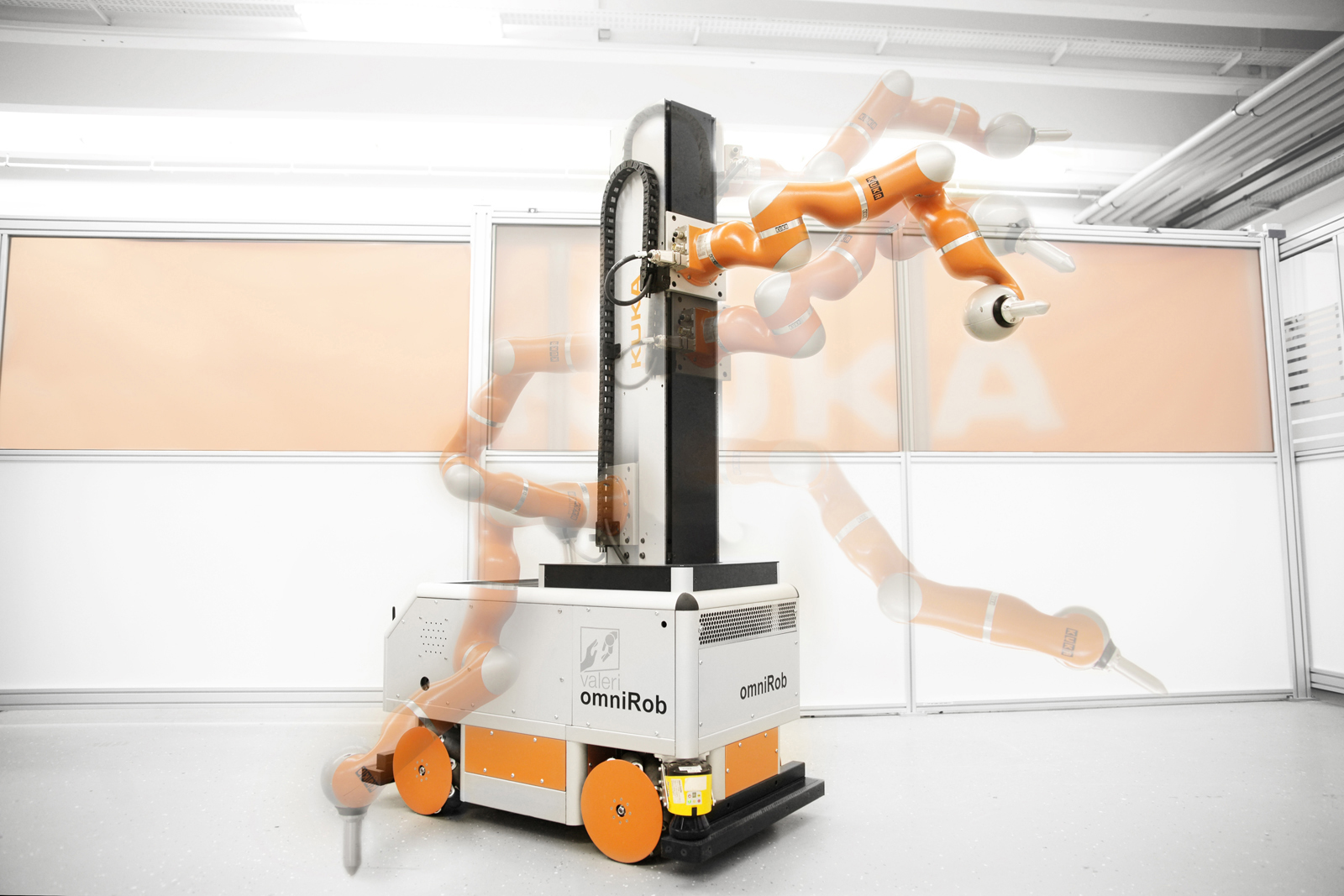Mobile robots support airplane manufacturers
In production facilities, robots, and people will soon be working side-by-side. A new mobile assistant is intended to support technicians in the airplane manufacturing industry when applying sealant, measuring, and testing – without putting them at risk.
The robots move at walking speed along airplane components; in doing so, it applies a sealant against corrosion in equal measure. The mobile assistant is surrounded by technical workers who install, drill, and test. Admittedly this scenario is still a glimpse of the future – but in just a few years, it should be reality for the aerospace manufacturing industry. In the EU project known as VALERI – short for Validation of Advanced, Collaborative Robotics for Industrial Applications – a European consortium is engineering a mobile robot that operates autonomously and moves independently through a production hall, and side-by-side with the engineers and technicians. It is not intended to replace the technician, but instead relieve them of stressful and monotonous duties and take over inspection duties. Airbus DS, FACC AG, IDPSA, Prodintec are involved with the plan, as well as KUKA Laboratories GmbH and Profactor GmbH. The management of this EU project is in the hands of the Fraunhofer Institute for Factory Operation and Automation IFF in Magdeburg. It is funded by a grant of approximately EUR 3.6 million.
“When we assemble fuselage elements, large quantities of sealant have to be applied to the joints. Mobile robots can take over this work quite well,” says José Saenz, head of project at IFF and general coordinator of VALERI. Stationary robots are not suited for the assembly of unwieldy airplane components several meters in length that are worked on over a period of up to two weeks inside one single facility. “For example, the elements of an airplane fuselage are too large for them to be adapted to a conventional production robot. You cannot rotate or turn them so that the system can work on them. So, it has to be the other way around. The robot drives to the desired location in the airplane,” say Saenz. Mobile systems are flexible, can be used at various stations, can move forward at various speeds, and are capable of performing delivery services – for example, they could retrieve tools for the technicians from a warehouse.
Touch-sensitive skin prevents collisions
The collaboration between people and equipment only works if collisions can be eliminated or kept to a minimum allowable level. The individual work must be absolutely certain in an environment in which automated assistants are constantly crossing paths with him or her. To guarantee one hundred percent security, Saenz and his team of colleagues outfitted the mobile platform with cameras and touch-sensitive interfaces that possess a cushioning layer. These sensors can be attached to the robot like an artificial skin. Using this technology – in combination with other optical sensors – unintended collisions are sensed and prevented. If a contact occurs again, then the robot stops or moves into another direction.
The mobile colleague is based on a robot from KUKA, the “omniRob.” Located on a drivable platform is a multi-extension grip arm; experts call it the manipulator. The complete system possesses 12 degrees of freedom. That means it can move not only forward, backward, up and down, but also move sideways and rotate. “The unique thing about our system is the coordinated movement of all degrees of freedom. While the platform is driving, the manipulator is moving at the same time. There has not yet been a system of this kind with such a large action radius, until now,” explains Saenz.
First test drive at year-end
The prototype is scheduled to take its first test drive by the end of this year. Tests under real life conditions are scheduled for October 2015: In a pilot program by Airbus DS, the mobile assistant must move autonomously, identify real airplane elements and solve tasks, without putting people at risk. “These mobile robots will change production processes in the aviation industry by accelerating production processes, making them more flexible, and by relieving technicians of burdensome tasks. With these robots, we are getting one step closer to the factory of the future,” says Saenz. These mobile helpers can also help in other industries such as shipbuilding or the production of wind turbines.
